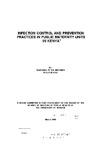| dc.description.abstract | Study objective was to establish the status of infection control and prevention
practices in maternity units within public hospitals in Nairobi, Kiambu and Thika
districts of Kenya.
Study design was descriptive cross-sectional survey that focused on infection
control and prevention practices of health care workers, within the maternity units
of public hospitals.
The setting was in Maternity units of Kenyatta National Referral Hospital,
Pumwani Maternity Hospital, Kiambu District Hospital, Thika District Hospital and
Tigoni Sub District Hospital.
Subjects, materials and methods. Health care workers including doctors,
nurses, clinical officers and support staff were observed and questionnaires
administered to them. Samples from disinfectants in use were collected and
analyzed in the laboratory, for growth of microorganisms. Medical records were
reviewed for mortalities, 24 months retrospectively. Caesarean section cases
were followed for postoperative morbidity 12 weeks prospectively. Photographs
were taken on various infection control and prevention facilities within the
institutions.
Main outcome measures. The observed practices were compared with the
recommended ICP practices based on the Standard Infection Control Practices
as laid down in the "AVSC Infection Prevention Participants Handbook (1999)".
Disinfectant in use test was done. Maternal morbidity and mortality were
evaluated and compared with the Kenya Demographic and Health Survey
findings.
Results. A majority (60.1 %) of health care workers (HCW) have at least 3.5
years of training. However, only 19.4% had attended update courses. The ICP
XVI
committees are present but not effective. Health care workers are aware that
they should practice infection control and prevention effectively. However, their
practice was found to be significantly below the recommended standards. In
addition, when disinfectants in use were tested for growth of microorganisms
40% of them failed when they grew mainly Staphylococcus, Enteric bacilli,
Proteus and Pseudomonas species. The prevalence rate of infections post
caesarian section was 132 per 1000 patients for the twelve weeks of study.
Infections were a major cause of maternal mortality, second to hemorrhage at
22.1% and 23.7% respectively. There was no significant correlation between the
infection rates and ICP practices by health care workers. This may have been
due to the practice of prophylactics and early use of antibiotics in the institutions
studied.
Conclusion. : Health care workers are lacking in updates courses on ICP
practices. This may be a contributing factor to the poor practices observed. The
situation is made worse by the lack of active infection control committees. Most
of the institutions studied use disinfectants wrongly. The poor practices may have
contributed to the occurrence of infections that are a major cause of both
maternal morbidity and mortality.
Recommendations
• Health care workers need to attend updates more frequently and regularly.
• The ICP committees need to be more active and effective
• Use of disinfectants need to be as per manufacturers recommendations.
• There is need for further studies in the area of ICP so as to improve on the
practices. | en_US |
| dc.description.department | a
Department of Psychiatry, University of Nairobi, ; bDepartment of Mental Health, School of Medicine,
Moi University, Eldoret, Kenya | |

